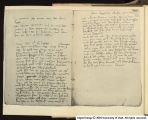| OCR Text |
Show 19 PAPERMAKIN drawing of wire. The draw-plate, made of metal or of hard precous stones, like most other appliances thought to have had thei origin in Europe, was without doub first used in the Orient man centuries before it was conceived in the Occident n France a company or guild of wiredrawers existed previou 1583, and in London there was an incorporated company unde the title of "The Art and Mystery of Drawing and Flattening o Wire." The motto of these artisans was Love draws friendship and they had their work-shops in Crooked Lane before the alterations in London Bridge. It is thought that iron wire was used firs as a mould covering at the introduction of papermaking int Spain, but the use of brass was centuries old at this time and bras s00n took the place of iron as a more suitable metal for the purpose In European moulds the wires were permanently fastened t the wooden frames, and in this way differed from the Orienta method of using detached covers. The European moulds wer rigid, so that the wet sheets of paper formed thereon were couche in a manner different from the Chinese or Persian fashion. Thi change constituted, in early centuries as at present, the greatest deviation between Oriental and Occidental methods of operation. I forming sheets of paper in the East the paper stock was kept fro flowing over the mould by the use of loose sticks, while in th ‘deckle and it not only prevented the macerated fibre from flowing ove the sides of the mould, but determined the size of the sheet o paper as well. The term deckle, which is now used in the English language, had its origin from either the German word "deckel or old Dutch "dekfcl," meaning cover. As the word was not use in England before the day of John Spilman, the German, who es Digital Imag © 2004 University of Utah. All rights reserved |



































































































































































































































































































































































































